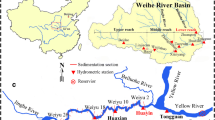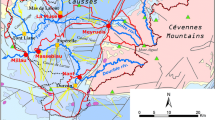Abstract
The (re)integration of flood storage areas in the river system is considered and proved as an effective flood protection measure. By their (controlled) filling and emptying, inundation risks for downstream areas with higher vulnerability can be reduced. They have an influence not only on the flood level, but also on the residence time of the water in the river ecosystem, which is an important biological parameter. A good prediction of storage flow is therefore necessary in an integrated ecosystem model. In such a model, which is being developed by the universities of Ghent and Antwerp, hydraulic, biological and biogeochemical processes are coupled. In this paper, a one-dimensional hydrodynamic module of the integrated STRIVE (STReam RIVer Ecosystem) model, which is based on the de Saint–Venant equations and solved by the Preissmann scheme, is adapted to be able to include flow exchange with storage cells. This model is validated with experimental laboratory measurements on a small scale. The flow between the storage cells and the river is controlled by weirs (flooded river banks). Model simulations with STRIVE are also compared with HEC-RAS simulations. Good agreement between simulations of both models and between the STRIVE simulations and the measurements is found.








Similar content being viewed by others
References
Buis K, Anibas C, Bal K et al (2007) Fundamentele studie van uitwisselingsprocessen in rivierecosystemen—geïntegreerde modelontwikkeling. Water 32:51–54 (in Dutch)
Chatterjee C, Förster S, Bronstert A (2008) Comparison of hydrodynamic models of different complexities to model floods with emergency storage areas. Hydrol Process 22(24):4695–4709. doi:10.1002/hyp.7079
Cunge JA, Holly FM, Verwey A (1980) Practical aspects of computational river hydraulics. Pitman Publishing, London
De Doncker L, Troch P, Verhoeven R, Bal K, Desmet N, Meire P (2009) Relation between resistance characteristics due to aquatic weed growth and the hydraulic capacity of the river AA. River Res Appl 25:1287–1303. doi:10.1002/rra.1240
Declercq F (2007) Overstromingsgebieden: experimentele opzet en numerieke modellering in “Femme”. Master Thesis, Ghent University (in Dutch)
Förster S, Chatterjee C, Bronstert A (2008) Hydrodynamic simulation of the operational management of a proposed flood emergency storage area at the middle. Elbe River River Res Appl 124:900–913. doi:10.1002/rra.1090
Gejadze IY, Monnier J (2007) On a 2D ‘zoom’ for the 1D shallow water model: Coupling and data assimilation. Comput Methods Appl Mech Eng 196:4628–4643. doi:10.1016/j.cma.2007.05.026
Gerard M, Rymen J, Beauchard O, El Kahloun M, Meire P (2008) Importance of mowing and flood frequency in promoting species richness in restored floodplains. J Appl Ecol 45(6):1780–1789
Henderson FM (1966) Open channel flow. The Macmillan Company, New York
Horritt MS, Bates PD (2002) Evaluation of 1D and 2D numerical models for predicting river flood inundation. J Hydrol 268:87–99
Huang S, Rauberg J, Apel H, Disse M, Lindenschmidt KE (2007) The effectiveness of polder systems on peak discharge capping of floods along the middle reaches of the Elbe River in Germany. Hydrol Earth Syst Sci 11:1391–1401
Hydrologic Engineering Center, US Army Corps of Engineers (2008) HEC-RAS river analysis system, Version 4.0. http://www.hec.usace.army.mil/software/hec-ras/
Jaffe DA, Sanders BF (2001) Engineered levee breaches for flood mitigation. J Hydrol Eng 127(6):471–479
Kneis D, Förster S, Bronstert A (2009) Simulation of water quality in a flood detention area using models of different spatial discretization. Ecol Model 220:1631–1642
Soetaert K, deClippele V, Herman P (2002) FEMME, a flexible environment for mathematically modelling the environment. Ecol Model 151:177–193
Wu W (2007) Computational river dynamics. Taylor & Francis Group, London
Acknowledgments
This research is funded by the FWO (Flemish Fund for Scientific Research) (G.0306.04) and fits in a multidisciplinary research project ‘A fundamental study on exchange processes in river ecosystems’(University of Antwerp, Vrije Universiteit Brussel, Ghent University, 2004–2009). The first author also wishes to thank the BOF (Bijzonder Onderzoeksfonds)—B/10677/02—BOF09/DOC/353 for personal funding.
Author information
Authors and Affiliations
Corresponding author
Rights and permissions
About this article
Cite this article
Meire, D., De Doncker, L., Declercq, F. et al. Modelling river-floodplain interaction during flood propagation. Nat Hazards 55, 111–121 (2010). https://doi.org/10.1007/s11069-010-9554-1
Received:
Accepted:
Published:
Issue Date:
DOI: https://doi.org/10.1007/s11069-010-9554-1




